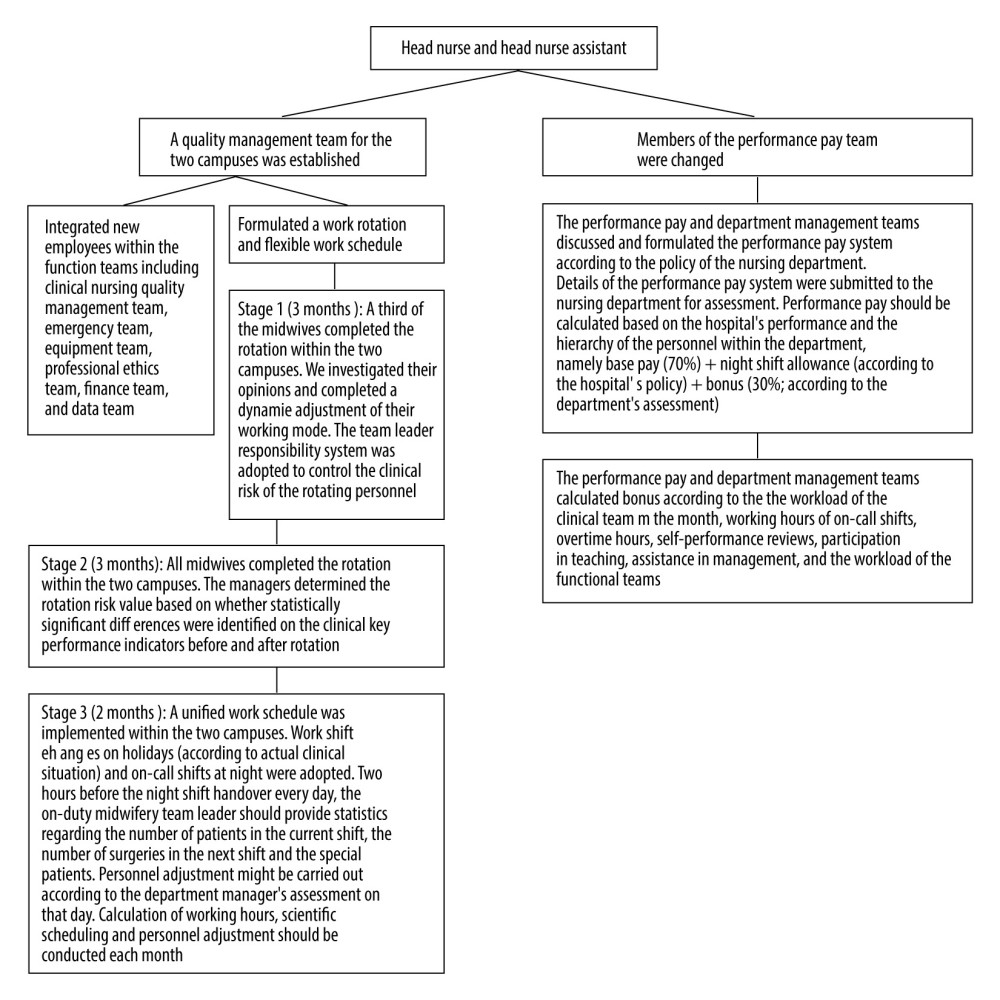08 November 2023: Clinical Research
Evaluation of the Impact of Management Changes on Midwives’ Attitudes: A Questionnaire-Based Comparative Study in a a Women’s and Children’s Hospital in China: A Questionnaire-Based Study
Zhuli Chen12AE, Ming Huang12BCE, Guoyu Wang12E*DOI: 10.12659/MSM.941683
Med Sci Monit 2023; 29:e941683
Abstract
BACKGROUND: Change management has become an important tool for hospitals to continuously improve themselves in a competitive market. This questionnaire-based study aimed to compare the attitudes of 78 midwives before and after management changes in work schedules and performance-related pay between March and October 2022 at a women's and children's hospital in China.
MATERIAL AND METHODS: The survey utilizing a job involvement scale and a self-designed questionnaire was distributed through WeChat group chat for all midwives of the hospital. The hospital has 87 midwives. A total of 78 midwives participated in the questionnaire survey.
RESULTS: The midwives' score ranges of work initiative, work attitude, work value, work recognition, and work enthusiasm and focus before change management were 21-39, 19-37, 23-29, 12-18, and 12-20, respectively, but that after change management they were 22-39, 19-37, 23-30, 13-18, and 14-23, respectively. After change management, both of the P values for work attitude and work enthusiasm and focus were less than 0.05, 80.23% of the midwives were willing to work across the 2 campuses, and all surveyed midwives agreed on unified accounting of performance pay under the condition of working across the 2 campuses. Their views changed from “maintaining the status quo: taking the initiative – passive resistance” to “questioning” to “openness to change: acceptance”.
CONCLUSIONS: The change management implemented within our department is feasible and the clinical risk is controllable. More attention was paid to the midwives' perceptions and humanized management was applied during change management, leading to a success of change.
Keywords: Job Satisfaction, Nurse Midwives, Salaries and Fringe Benefits, Surveys and Questionnaires
Background
In recent years, with a social and economic transformation and the continuous increase of people’s health demands, hospitals are facing a number of challenges. To solve these challenges and actively adapt to social needs, change management has become an important tool for hospitals to continuously improve themselves in a competitive market. Unlike traditional businesses, healthcare organizations are more complex, with a wide range of professional and multi-dimensional objectives. Therefore, transformative practices in the healthcare sector may be more difficult [1].
Harold J. Levitt, an American management psychologist, believes that an organization is a multi-variable system containing at least 4 important variables: tasks, technology, personnel, and structure. Personnel reform is the most complex and difficult activity in organizational reform because it involves changes in the attitude, motivation, behavior, professional ethics, interpersonal relationship, and culture of the organization members [2].
Healthcare organizations need to implement change management strategies to effectively respond to challenges and changes in the healthcare industry, such as increased healthcare demands, technological advancements, financial pressures, and policy changes [3]. For midwives, proper training programs and professional regulation can help them improve midwifery skills. This is an essential response to the lack of high-quality maternal and neonatal care [4,5]. There has been little research on change management concerning midwives’ work schedules and performance-related pay. Therefore, this questionnaire-based study aimed to compare the attitudes of 78 midwives before and after management changes in work schedules and performance-related pay between March and October 2022 at a women’s and children’s hospital in China.
Material and Methods
ETHICS APPROVAL:
This study was approved by the Medical Ethics Committee of our institution [2023 Medical Scientific Research for Ethical Approval No. (155)]. Informed consent to participate in this study was obtained from all participants.
STUDY SETTING:
Our hospital is a tertiary Grade A women’s and children’s hospital, integrating medical treatment, teaching, research, disease prevention, health care, and talent training. The National Maternal and Child Health Monitoring Office, Sichuan Provincial Maternal and Child Inspection and Quality Control Center, Sichuan Provincial Critical Pregnant Women Treatment Center, and Sichuan Provincial Maternal and Infant Nursing Training Base were established within our hospital. The hospital has 2 campuses and 87 midwives in the Obstetrics Department. The total number of births in the 2 campuses is around 1500 cases per month. The midwives in our hospital work in a variety of positions, such as dealing with childbirth, circulating and instrument nurses for cesarean section, management quality control, research, and teaching.
After the second campus was established 3 years ago, the workload in the new campus increased sharply, and was twice than that of the old campus. The midwives working in the new campus have a heavy workload, with a total of more than 3000 h overtime a year. The rate of acute and critical illness is 56.8% and the successful rate of rescue is 22.51%. Due to high stress levels at work and a fast work pace, the midwives in our department have seen a decline in job satisfaction and a high quit rate. Nursing managers should actively seek solutions to these problems – change management. Research by Yousefi et al [1] shows that the important factors in conflict solutions and change management are problem identification and initial support; research, design, and planning; participation in the execution; considering enforcement requirements; and implementation, evaluation, feedback, and stabilization. It is necessary to first determine the sources of conflicts, including the types, ways, and causes of conflicts [6,7], to manage the conflicts.
STUDY TOOLS:
The survey utilizing the job involvement scale formulated by Qin [8] and a self-designed questionnaire was conducted with the midwives working in our department before and after change management within the department from March 2022 to October 2022. The survey was distributed through WeChat group chat for all midwives of our hospital. All 78 on-duty midwives participated in the questionnaire survey, excluding the 9 midwives who were on leave.
The job involvement scale was used to investigate the job involvement of the midwives before and after change management. The scale was validated and showed good reliability [9–11]. It contains 5 components: work initiative (9 items), work attitude (8 items), work value (6 items), work recognition (4 items), and work enthusiasm and focus (5 items), totaling 32 items. A 5-point Likert scale was used to rate the respondent’s answers. A score ranging from 1 to 5 was assigned to the 5 response options: “disagree strongly”, “disagree”, “agree slightly”, “agree”, and “agree strongly”. The scale score ranged from 32 to 160. The higher the scale score, the higher the level of job involvement. The Cronbach’s alpha coefficient of this scale was 0.958.
The midwives’ perceptions of work scheduling and performance pay systems were investigated by the following questions: (1) Would you like to work across the 2 campuses? (2) Do you accept flexible work scheduling (namely adjusting the work time and campus of work on the scheduled date of work)? (3) Why are you willing to change? (4) Why aren’t you willing to change? and (5) Do you accept the unified accounting of performance pay?
STATISTICAL ANALYSIS:
Data were input in an Excel worksheet. SPSS 26.0 was used for data analysis. Normality test was performed on enumeration data. The independent-samples
METHODS OF CHANGE:
The conflicts concerning work scheduling and performance pay systems occurred due to independent management. Heavy workload, time pressure, uneven allocation of resources, role ambiguity (midwives work in operating rooms), and uncertain working hours were the main organizational factors leading to conflicts. Previous studies [12–14] have shown that the main causes of organizational conflict factors include a heavy workload, time pressure, resource scarcity, unclear job description and responsibilities, role ambiguity, job uncertainty, poor communication, occupational stress, unclear rules and policies, management expectations, and organizational changes. Working together to solve problems requires mutual respect and drive to find mutually satisfying agreements that contribute to trust, satisfaction, and equity, so as to provide better outcomes for the team and the patients [15].
The results of Specchia et al [16] show that transformational leadership has the highest positive correlation coefficient with employee satisfaction. Therefore, the head nurse actively conducted the change, supported and integrated new employees within the established medical team, encouraged mutual respect among all team members, and established a positive working relationship. For those who did not want to work across the 2 campuses, humanized management was applied after understanding their situations. Those who required more than 1 h of commuting time were allocated to the campus closest to their home. For those who actively adapt to changes, their posts and working places should be adjusted reasonably. The change process is divided into 3 stages (Figure 1). Our department management conducted interviews with the midwives at each stage.
The change of work scheduling and performance pay systems was conducted in both campuses. The new work scheduling requires the allocation of a team leader, who possesses strong working competence and rich midwifery experience, to each work shift. The team leader cooperated with other midwives, fully developing the subjective initiative of the midwives with rich work experience, promoting the rapid growth of junior midwives with insufficient work experience, and meeting the midwives’ needs to realize their self-fulfillment. The new work scheduling mode can result in adequate manpower for the night shift, thereby relieving the midwives’ working stress. The differences in per capita workload and performance pay of the midwives between the 2 campuses were decreased, so their work initiative and the quality of midwifery care were improved accordingly.
Results
JOB INVOLVEMENT:
The midwives’ scores concerning job involvement before and after change management are presented in Tables 1 and 2. Comparison in job involvement before and after change management is presented in Table 3.
ATTITUDES ABOUT WORK SCHEDULES AND PERFORMANCE-RELATED PAY:
The midwives’ attitudes about work schedules and performance-related pay are presented in Table 4.
Discussion
STAGE 1: UNFREEZING:
At this stage, the department realized the gap between the new reality and the past, and that there were unreasonable workload, personnel arrangements, and inappropriate performance pay system at the 2 campuses. The department needed to break the old structure and management behavior to prepare for a new vision for the future. The hospital managers communicated with other attendees in the monthly meeting of the quality management team. The persons who attended the meetings explained the purpose, goals, specific measures, and specific tasks of each member in a relaxed setting.
STAGE 2: CHANGE:
The core members at this stage led individuals or the entire organization. They implemented change using new attitudes, values, and behaviors. Managers explained to other employees the reasons for change, effective working methods, work procedures and specific work arrangements, analyzed the possible impact of change, and actively encouraged employees to participate in the change.
As a special group of people in the nursing team, midwives play a very important role in the Obstetrics Department to ensure the safety of lying-in women and newborns. With the launch of the two-child policy in China, the number of second-child births has increased sharply, and the shortage of midwifery personnel in China has become more prominent [18]. Midwives may feel fatigue at work, which can cause psychological problems and a decline in the quality of their work.
To alleviate the shortage of midwifery human resources and ensure midwifery safety, flexible work scheduling in combination with a full-responsibility midwifery system in the management of obstetrics departments have been developed in recent years, and these actions have achieved positive effects [19,20]. Referring to the “ROTA” nurse scheduling system [21], our department uses the intelligent scheduling mode, combines flexible work scheduling with grouping scheduling, considers the optimal allocation for nurse shifts, and takes into account various limiting factors, such as shift time, holidays, and emergencies. This helps to optimize human resource management, increase midwives’ job satisfaction, and improve the quality of midwifery work. The 2 campuses have a unified schedule, and allow work shift changes on holidays and on-call shifts at night. For work scheduling, many constraints need to be considered, which can make daily scheduling a challenging task. Head nurses can obtain more opinions about scheduling from other stakeholders, and this can improve their understanding of scheduling.
Nursing staff reallocation in a management process contains 3 aspects: (1) sudden absences from work; (2) allocation and reallocation of available nursing staff; and (3) financial resources required to compensate for sudden absences from work. Schreuder et al [22] and Clark et al [23] found that sudden absences from work, such as sick leave, are the main reason for the shortage of nursing staff. Allocation and reallocation of nursing resources is a daily challenge and a time-consuming task for nursing managers, who must ensure 24-h staff availability every day. The ability to keep employees satisfied is an important factor for any organization to achieve its goals. This can transform into an approach to improve employee performance and productivity [24], thereby optimizing human resource management, improving midwives’ job satisfaction, and improving the quality of midwifery work.
Establishing a reasonable payment distribution and work performance appraisal system for nursing staff is an important part of the development of the nursing field and reform of the national medical and health system in China. Our hospital implements a vertical nursing administration mode to quantitatively evaluate nursing staff’s performance. For example, 30% of performance pay is associated with the workload of the clinical team in the month, the working hours of on-call shifts, overtime hours, self-performance reviews, participation in teaching, assistance in management, and the workload of the functional teams. Employees who work longer hours and have a heavy workload get more pay. The continuous improvement of a nursing performance payment distribution scheme can stimulate nursing staff’s work enthusiasm and improve their job satisfaction. The performance payment distribution mode after the reform becomes an objective and fair way to evaluate the nursing staff’s work performance. Following the reform of the nursing performance payment distribution system, performance pay is now calculated according to the coefficient value of the nursing project, which can reflect the policy of more pay for more work, improve staff’s self-worth and sense of responsibility, and encourage the nursing staff [25,26].
At this stage, flexible work scheduling and performance pay distribution system reform are accepted by employees.
STAGE 3: REFREEZE:
This stage is the reinforcement phase of the changed behavior, through which the new behavior pattern is standardized and institutionalized through reinforcement and support mechanisms. The hospital has formed a system for the reformed scheduling model and performance pay, and made a plan that every employee is aware of. After the change is implemented, the employees’ psychological state and behaviors are consolidated and strengthened.
Organizational change may encounter resistance in the form of adjustment of interpersonal relationships, reallocation of resources, adjustment of organizational structure, personal loss, and change of individual values. Leadership roles and stakeholders are important in overcoming resistance to change. When managers implement change, in addition to supporting the change plan through various theories and literature, they still need to listen to the opinions of the nursing staff, especially those who are unwilling to change. As the changes progressed, their views changed from “maintaining the status quo: taking the initiative - passive resistance” to “questioning” to “openness to change: acceptance.”
Respondents with a negative attitude said: “I am not willing to change my current work site. First, my home is too far away from the other campus. A change of work site will take me twice the commuting time. Second, I am not familiar with the environment of the other campus. I am not very willing to adapt and get familiar with it. It is not appropriate to work in the campus in the morning but transfer to the other campus in the afternoon. My safety on transportation for the change of work site may not be ensured. Flexible work scheduling makes me very upset. I do not know whether I should arrange other things to do or wait for the head nurse to arrange work for me. However, after the change was implemented for a while, it seems that the change is acceptable. I do not care about it. The main site of work is still in the campus I am working in, and other staff seem to adapt to it.”
Respondents with a positive attitude said, “It is okay to work in either of the campuses because the work is the same.”
The respondents also thought of the need for change, and their colleagues’ perceptions might have affected a change in their attitudes.
“Is it really possible to arrange shifts like this? Why don’t you recruit new employees if there are insufficient employees?”
“She is in the same situation as me. Everyone seems to be like this, and the change does not seem to be unacceptable.”
In the process of change management, managers need to understand the ideas of staff, give them feedback and guidance, and implement humanized management so as to improve the success rate of change management. In our study, the management of our department helped midwives understand the advantages of management changes and increased their participation in changes using training and communication. The midwives’ income was calculated based on their workload and work performance after management changes, motivating the midwives and influencing their work attitude and work enthusiasm and focus.
LIMITATIONS:
This study was conducted at a single center in China, which may limit the application of our results to different healthcare settings.
Conclusions
The change management implemented within our department is feasible and the clinical risk is controllable. More attention was paid to the midwives’ perceptions and humanized management was applied during change management, leading to successful change.
When conflicts occur in hospital departments, managers should immediately change their thinking from traditional work scheduling and performance pay systems to the ideal flexible work scheduling and reasonable performance pay systems. They should use scientific nursing performance evaluation indicators to conduct multi-dimensional nursing performance evaluations among individuals, departments, and the hospital. Nursing managers should combine performance and personnel arrangements with benefit adjustments. People who have a high-quality work performance or heavy workload should receive more income. This can stimulate the work initiative of nursing staff, and help to improve their job satisfaction and enthusiasm, thereby improving the quality of nursing.
There are 2 major tasks in promoting organizational change and innovation: developing learning ability and building organizational culture. An important responsibility of managers is not to manage people, but to develop people. All people need appropriate training to develop their communication skills and conflict management strategies, as conflicts in the work environment can put stress on staff and affect the quality of nursing and job satisfaction. Hospital managers should also create a culture that employees respect and apply organizational culture to conflict management. The organizational culture of the department belongs to the hierarchy according to the competitive values framework, and should become more cooperative. It is important to care about employees and establish a friendly and supportive working environment through teamwork.
References
1. Yousefi M, Mashhadi L, Akbarisari A, Ebrahimi Z, Change management in hospitals: A framework analysis: Stud Health Technol Inform, 2022; 299; 262-68
2. Zhang Y: Management, 2013, Tianjin (China), Nankai University Press
3. Campbell RJ, Change management in health care: Health Care Manag (Frederick), 2020; 39(2); 50-65
4. Utz B, Halim A, Improving midwifery care worldwide: Lancet, 2015; 385(9962); 26-27
5. Khosravi S, Babaey F, Abedi P, Strategies to improve the quality of midwifery care and developing midwife-centered care in Iran: Analyzing the attitudes of midwifery experts: BMC Pregnancy Childbirth, 2022; 22(1); 40
6. Pondy LR, Reflections on organizational conflict: J Org Behav, 1992; 13(3); 257-61
7. Barr J, Dowding L: Leadership in healthcare, 2012, London (GB), SAGE Publications
8. Qin H, Wu J, Wang T, Wu J, Zhou JDevelopment and psychometric testing of the specialty nurse work engagement scale: Journal of Nursing Science, 2022; 37(1); 56-9 [in Chinese]
9. Xiao X, Teng S, An JAnalysis of operating room nurses’ work involvement and influential factors: Chinese General Practice Nursing, 2023; 21(19); 2717-19 [in Chinese]
10. Liang R, Sunzi K, Zeng LEvaluation of work engagement and its determinants in operating room specialist nurses in Sichuan province: Journal of Nursing Science, 2023; 38(4); 40-44 [in Chinese]
11. Zeng L, Wang J, Jin MResearch progress on the relationship between nurses’ psychological capital, organizational commitment and work engagement: Journal of Modern Clinical Medicine, 2023; 49(3); 176-79 [in Chinese]
12. Graham S, The effects of different conflict management styles on job satisfaction in rural healthcare settings: Economics and Business Journal: Inquiries and Perspectives, 2009; 2(1); 71-85
13. Pavlakis A, Kaitelidou D, Theodorou M, Conflict management in public hospitals: The Cyprus case: Int Nurs Rev, 2011; 58(2); 242-48
14. Pitsillidou M, Farmakas A, Noula M, Roupa Z, Conflict management among health professionals in hospitals of Cyprus: J Nurs Manag, 2018; 26(8); 953-60
15. Posthuma RA, Conflict management and performance outcomes: Int J Confl Manage, 2011; 22(2); 108-10
16. Specchia ML, Cozzolino MR, Carini E, Leadership styles and nurses’ job satisfaction. Results of a systematic review: Int J Environ Res Public Health, 2021; 18(4); 1552
17. Mind Tools Content Team: Lewin’s change management model Available from: https://www.mindtools.com/ajm9l1e/lewins-change-management-model
18. Gu SOccupational stress and countermeasures of midwives in the two-child era: The Medical Forum, 2018; 22(12); 1722-24 [in Chinese]
19. Tang ZCombination of flexible work scheduling and full responsibility midwifery system in the management of maternity ward: Today Nurse, 2012(2); 183-84 [in Chinese]
20. Zhou PFlexible work scheduling of midwives and rational utilization and management of nursing human resources: Journal of Traditional Chinese Medicine Management, 2018; 26(15); 92-93 [in Chinese]
21. D’Souza B, Rao SS, Muthana CG, ROTA: A system for automated scheduling of nursing duties in a tertiary teaching hospital in south India: Health Informatics J, 2021; 27(2); 14604582211001426
22. Schreuder JA, Roelen CA, Van Zweeden NF, Leadership styles of nurse managers and registered sickness absence among their nursing staff: Health Care Manage Rev, 2011; 36(1); 58-66
23. Clark A, Moule P, Topping A, Serpell M, Rescheduling nursing shifts: Scoping the challenge and examining the potential of mathematical model-based tools: J Nurs Manag, 2015; 23(4); 411-20
24. Wheatley D, Employee satisfaction and use of flexible working arrangements: Work Employ Soc, 2016; 31(4); 567-85
25. Feng JRBRVS localization and its application in hospital performance assessment: China Chief Financial Officer, 2019; 17(4); 82-84 [in Chinese]
26. Zhang YThe influence of performance assessment on improving the quality of nursing management in Department of Respiratory Medicine: Chinese and Foreign Medical Research, 2017; 15(10); 83-85 [in Chinese]
Tables
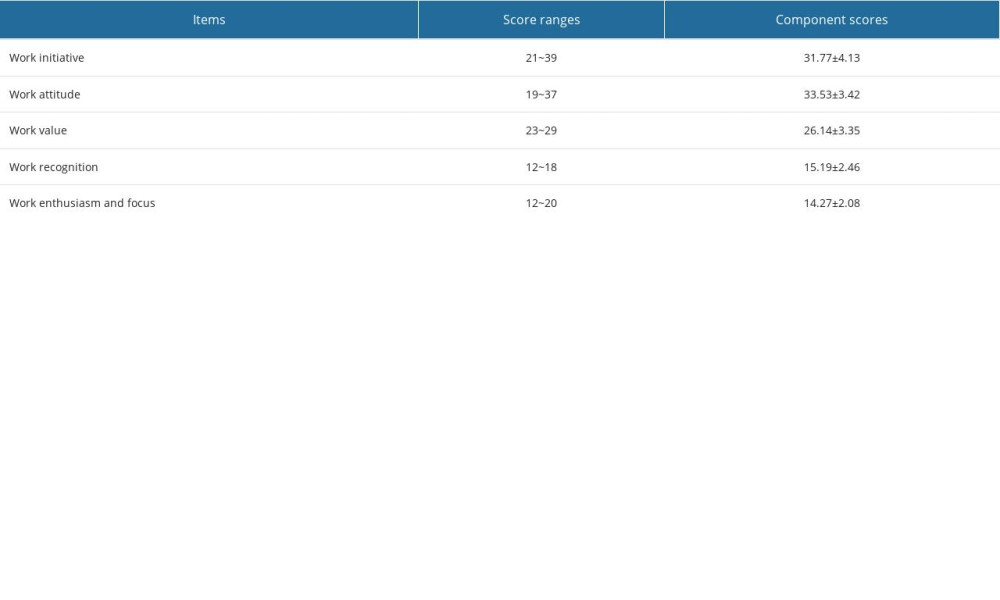 Table 1. Scores for job involvement before change management.
Table 1. Scores for job involvement before change management.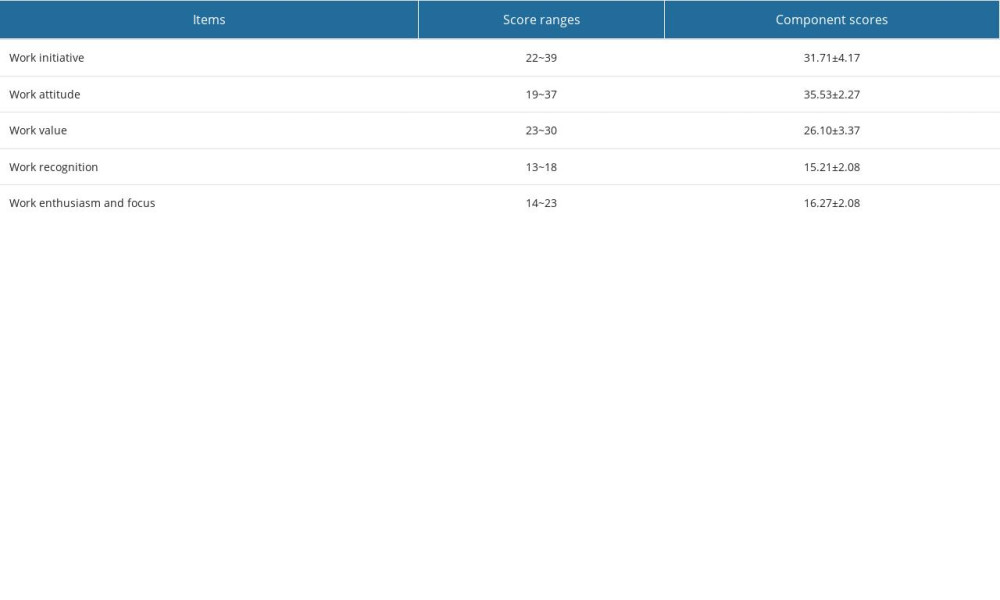 Table 2. Scores for job involvement after change management.
Table 2. Scores for job involvement after change management.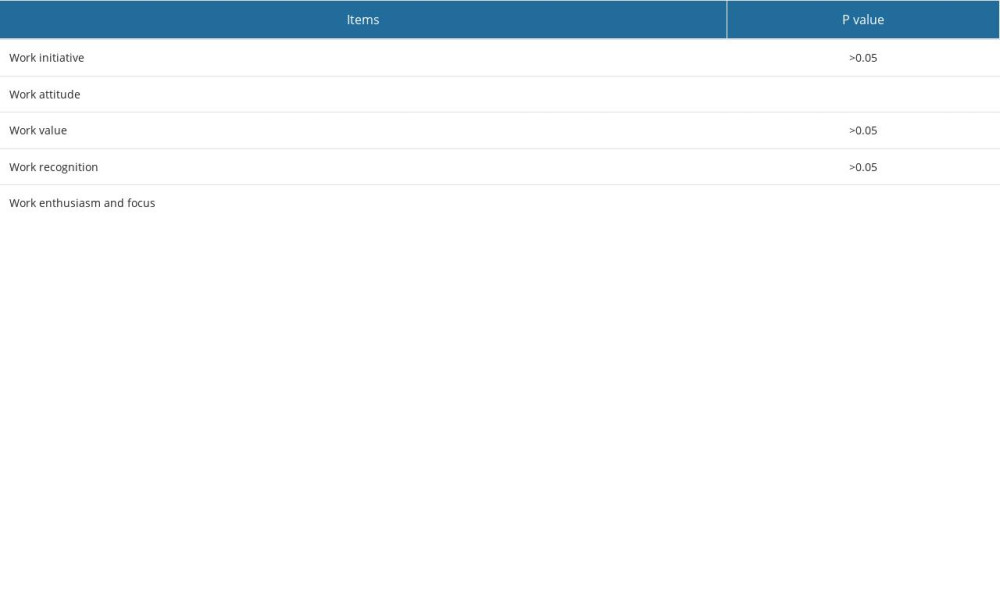 Table 3. Comparison in job involvement before and after change management.
Table 3. Comparison in job involvement before and after change management.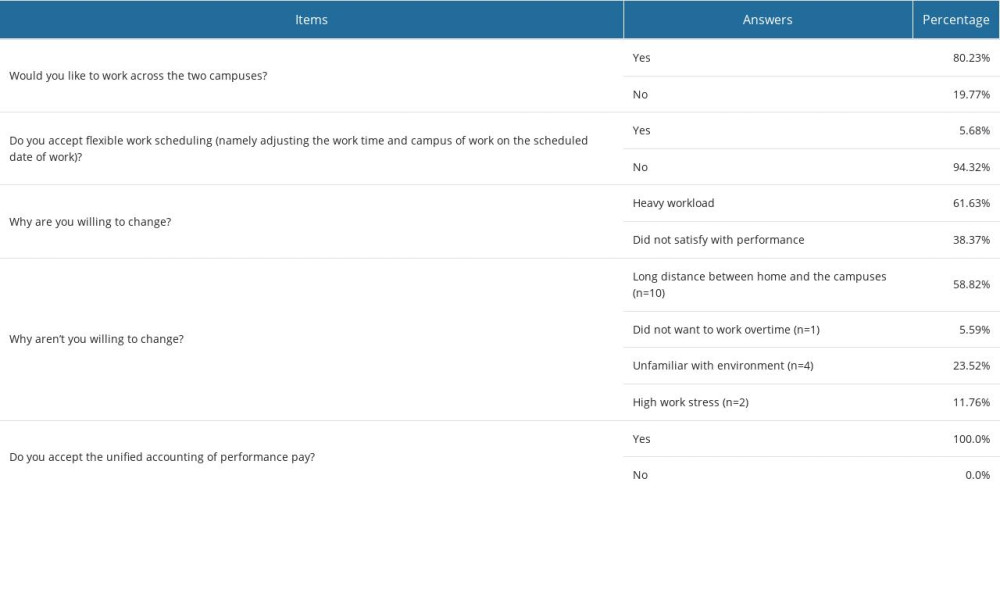 Table 4. Midwives’ perceptions of work scheduling and performance pay systems.
Table 4. Midwives’ perceptions of work scheduling and performance pay systems. Table 1. Scores for job involvement before change management.
Table 1. Scores for job involvement before change management. Table 2. Scores for job involvement after change management.
Table 2. Scores for job involvement after change management. Table 3. Comparison in job involvement before and after change management.
Table 3. Comparison in job involvement before and after change management. Table 4. Midwives’ perceptions of work scheduling and performance pay systems.
Table 4. Midwives’ perceptions of work scheduling and performance pay systems. In Press
12 Mar 2024 : Clinical Research
Tissue Inhibitors of Metalloproteinase 1 (TIMP-1) and 3 (TIMP-3) as New Markers of Acute Kidney Injury Afte...Med Sci Monit In Press; DOI: 10.12659/MSM.943500
12 Mar 2024 : Review article
Optimizing Behçet Uveitis Management: A Review of Personalized Immunosuppressive StrategiesMed Sci Monit In Press; DOI: 10.12659/MSM.943240
12 Mar 2024 : Clinical Research
Metabolomic Alterations in Methotrexate Treatment of Moderate-to-Severe PsoriasisMed Sci Monit In Press; DOI: 10.12659/MSM.943360
14 Mar 2024 : Clinical Research
Renal Dysfunction Increases Risk of Adverse Cardiovascular Events in 5-Year Follow-Up Study of Intermediate...Med Sci Monit In Press; DOI: 10.12659/MSM.943956
Most Viewed Current Articles
17 Jan 2024 : Review article
Vaccination Guidelines for Pregnant Women: Addressing COVID-19 and the Omicron VariantDOI :10.12659/MSM.942799
Med Sci Monit 2024; 30:e942799
14 Dec 2022 : Clinical Research
Prevalence and Variability of Allergen-Specific Immunoglobulin E in Patients with Elevated Tryptase LevelsDOI :10.12659/MSM.937990
Med Sci Monit 2022; 28:e937990
16 May 2023 : Clinical Research
Electrophysiological Testing for an Auditory Processing Disorder and Reading Performance in 54 School Stude...DOI :10.12659/MSM.940387
Med Sci Monit 2023; 29:e940387
01 Jan 2022 : Editorial
Editorial: Current Status of Oral Antiviral Drug Treatments for SARS-CoV-2 Infection in Non-Hospitalized Pa...DOI :10.12659/MSM.935952
Med Sci Monit 2022; 28:e935952









